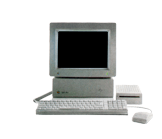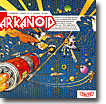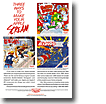Arkanoid
Your Rating: Not Yet Rated
Average Rating: 4.5 (18 people have rated this item.)
RAM Requirement: 512k RAM
Control: Mouse
Release Status: Abandonware
Year: 1988
Publisher: Taito America
Developers: Ryan Ridges & John Lund
System 6 Compatible: Yes
Hard Drive Installable: Yes
 Download 2image Archive (1043k)
Download 2image Archive (1043k)
 Download the manual in PDF format (182k)
Download the manual in PDF format (182k)
All ebay results related to this archive:
Vintage Apple IIGS Computer game ARKANOID box Rare
Vintage Software Apple II IIgs Game Arkanoid II Revenge of Doh NIP Sealed
Vintage Apple IIGS Computer game ARKANOID box Rare
1989 Vintage Apple Computer Tech Print Ad Taito Arkanoid IBM EGA/VGA Game Video
Current Apple IIGS related Auctions Listed By Time Left:
Vintage Software Apple II IIe IIc IIgs RUSSIA The Great War in the East
LEGO TC Logo - Super Rare DACTA - APPLE IIe & IIgs - Interface Card & Cable 9767
Apple ADB Touchpad Mouse Mice Replacement for G5431 m1042 M2706 A9M0331 IIGS IIe
Phonics Prime Time 1.0 by MECC for Apple II+, Apple IIe, Apple IIc, Apple IIGS
Sound Tracks 1.0 by MECC for Apple II+, Apple IIe, Apple IIc, Apple IIGS
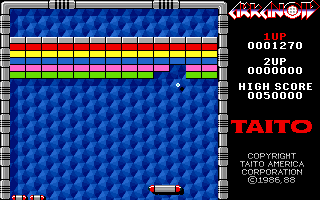
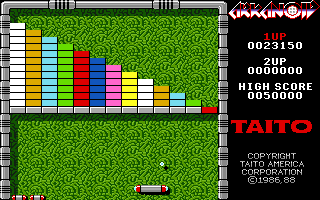
Based on the old Atari game of Break Out (which is well known for having been developed by both Steve Wozniak and Steve Jobs) which was released way back in the late 70s as a single player version of Pong.
All three games share a similarity - a paddle, a ball and a need to hit the ball with the paddle. Break Out varied from Pong in that it hit the ball with the paddle to remove rows of bricks as opposed to hitting the ball and then watching the same step taken by your opponent's paddle. Arkanoid differed in that not only do you bounce the ball from your paddle onto bricks, you could bounce multiple balls onto the many patterns of bricks. You could shoot the bricks with a laser; you could bounce a ball into pesky aliens to destroy them, only to veer your ball in unexpected directions; you could extend or magnetise your paddle.
The game is repetitive but therein lies the fun it requires quick reflexes and strategies to remove each brick from every level as quickly as possible before the ball gains more speed than you can handle. The power ups in Arkanoid are the capsules or pills that randomly drop down from destroyed bricks and give your paddle power ups. A red capsule labelled "L" will give your paddle the ability to shoot lasers with a click of the mouse. A cyan capsule labelled "D" will give you three balls ("D" standing for divide). A green "C" capsule will make the ball stick to your paddle. And there are other power ups, which I won't spoil for you so you can find out for yourself.
Arkanoid for the IIGS is one terrific game. The graphics are wonderfully crisp and colourful, if not arcade perfect and the gameplay and animation constantly smooth. The music sounds even better than the arcade and you couldn't tell the sound effects apart from the arcade original. A faithfully ported arcade game only made better thanks to Ryan Ridges and John Lund.
